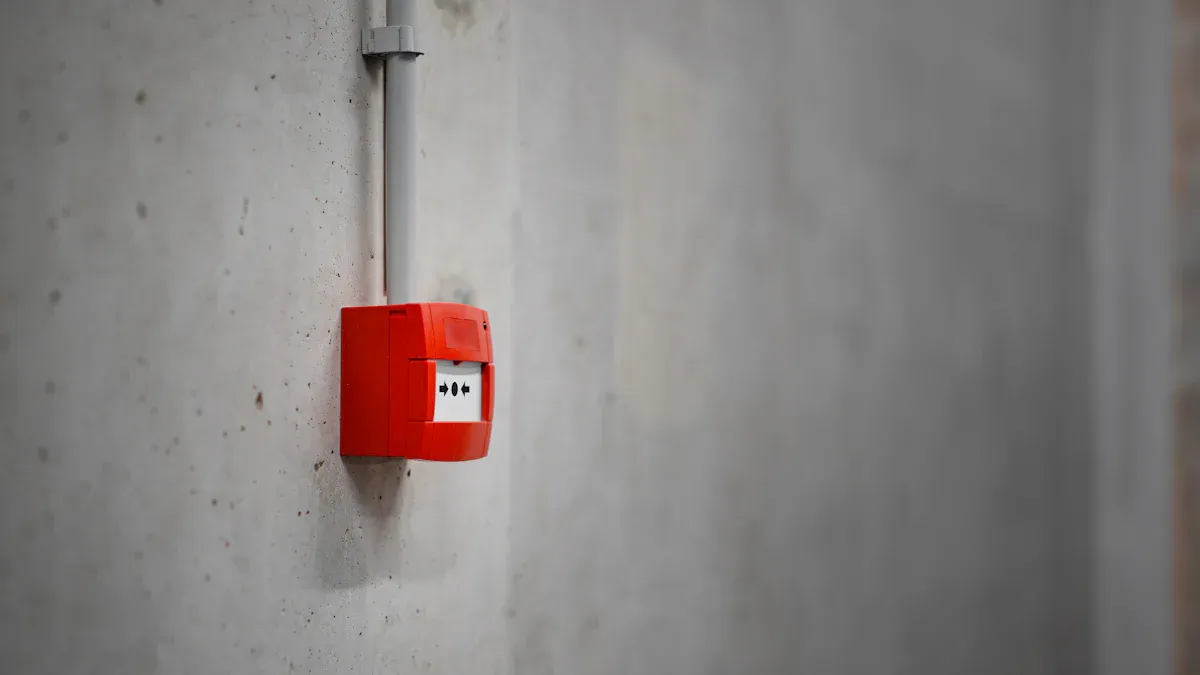
Explosion-proof compliance for your robotic lithium battery packs demands a clear understanding of hazardous area classifications, especially in class i locations and class ii locations. You must select the right explosion-proof certifications, considering unique risks across sectors:
Oil and gas: pipeline inspection
Chemical: hazardous material handling
Mining: safety monitoring
Risk Type | Description |
|---|---|
Regulatory Risk | Non-compliance leads to heavy fines and penalties. |
Operational Risk | Lithium batteries can cause catastrophic fires. |
Liability Risk | Insurers increase premiums due to shipment risks. |
Business Interruption | Incidents disrupt operations and cause financial losses. |
You should design for both explosion-proof and intrinsically safe devices, then document and certify each step.
Key Takeaways
Understand hazardous area classifications to select the right explosion-proof certifications for your robotic battery systems.
Prioritize intrinsic safety in design by limiting electrical and thermal energy to prevent ignition in explosive environments.
Maintain thorough documentation and quality control throughout production to ensure compliance and streamline future audits.
Part 1: Explosion-Proof Certifications

Explosion-proof certifications play a critical role in protecting robotic battery systems in hazardous environments. You must understand how these certifications ensure that your equipment can operate safely where explosive gases or dust may be present. These certifications help you meet legal requirements, reduce operational risks, and support safe deployment in sectors like oil and gas, chemical, mining, and industrial automation.
1.1 Key Standards: ATEX, IECEx
You will encounter two main standards for explosion-proof certifications: ATEX and IECEx. Both standards address the safety of equipment in explosive atmospheres, but they differ in important ways:
ATEX is mandatory in the European Union and is a legal requirement for all equipment in hazardous locations.
IECEx is recognized globally and is based on international standards, not laws.
ATEX certification applies to both electrical and non-electrical equipment, while IECEx focuses on electrical equipment.
IECEx requires third-party verification, making it more stringent.
ATEX certification is only valid within the EU, while IECEx is accepted worldwide.
You should select the standard that matches your deployment region and application. For more details, refer to ATEX Directive (EU) and IECEx System.
1.2 Hazardous Area Classification
Before you select explosion-proof certifications, you must classify the hazardous area where your robotic battery system will operate. This process uses standards like EN 60079-10-1, which defines explosive atmospheres for the presence of gas. The classification depends on the type of battery and its application:
Battery Type | Description |
|---|---|
Traction Batteries | Used for handling forklift trucks, lifting platforms, cleaning machines, and power generators in classified areas. |
Stationary Batteries | Installed in special rooms to generate direct current, configured in series or parallel for specific plant needs. |
Relevant Standard | EN 60079-10-1: Classification of places – Explosive atmospheres for the presence of gas. |
You must conduct a thorough risk assessment for each robotic system. Both manufacturers and integrators need to assess risks, and facilities must perform their own assessments after installation.
1.3 Certification for Lithium Battery Systems
Certifications for lithium battery systems require you to follow strict standards. Certification bodies evaluate your battery packs using standards such as UL 1973, which ensures safety and reliability for stationary battery systems, and UL 9540A, which addresses fire safety and thermal runaway risks in energy storage systems.
Standard | Description |
|---|---|
UL 1973 | Ensures safety, reliability, and operational capability of stationary battery systems across various applications. |
UL 9540A | Focuses on fire safety hazards and thermal runaway risks in Energy Storage Systems (ESS). |
Explosion-proof certifications and intrinsically safe devices both play a role in compliance. Explosion-proof equipment contains potential ignition sources, while intrinsically safe devices limit energy to prevent ignition. You must select the right approach based on your application and the standards that apply.
Part 2: Intrinsically Safe Devices and Design

2.1 Intrinsic Safety Principles
You must prioritize intrinsic safety when designing lithium battery packs for robots operating in hazardous locations. Intrinsically safe devices protect low-energy systems from hazards in explosive environments by limiting electrical and thermal energy. You need to certify each device for specific hazardous locations, ensuring compliance with safety standards and explosion-proof classification.
Intrinsically safe devices prevent ignition sources within the equipment.
You must consider entity parameters such as maximum voltage, current, and power to maintain safety in circuits.
Intrinsically safe rating ensures that your system meets the requirements for hazardous area certified products.
Intrinsic safety differs from explosion-proof design approaches. Intrinsically safe systems focus on prevention, reducing energy levels to minimize ignition risk. Explosion-proof equipment relies on robust housing to contain explosions. Intrinsically safe devices may introduce more potential points of failure compared to explosion-proof solutions, but they offer increased safety in environments with gases and vapor hazards.
Tip: Always verify that your intrinsically safe devices meet the certification requirements for class iii locations and hazardous conditions. This step helps you avoid regulatory risk and ensures safe operation in all hazardous locations.
2.2 Voltage and Energy Limits
You must control voltage and energy limits to achieve intrinsic safety in robotic battery systems. These limits directly affect performance and safety in hazardous conditions. The following table summarizes recommended parameters for lithium battery packs:
Parameter | Recommended Limits |
|---|---|
Charging Temperature | 0°C to 45°C |
Discharging Temperature | -20°C to 60°C |
Storing Temperature | 0°C to 20°C |
Charging Voltage | Not exceeding 4.3 V |
Discharging Voltage | Not less than 2.3 V |
Charge Current | 0.1 C to 1.0 C |
Discharge Current | Up to 2 C |
You must select lithium battery chemistries that support these limits. For example, lithium-ion, LiFePO4, lithium-polymer, and solid-state battery chemistries offer different safety profiles. You should use a battery management system (BMS) to monitor and enforce these parameters. Intrinsically safe rating depends on strict adherence to these limits, especially in hazardous conditions.
Note: You should always configure your charging and discharging circuits to stay within recommended voltage and current limits. This practice reduces the risk of ignition and supports intrinsically safe devices in hazardous area certified products.
2.3 Enclosure and PCB Design
You must pay close attention to enclosure and PCB design when developing intrinsically safe devices for robotic lithium battery packs. The enclosure must isolate the battery system from hazardous conditions, supporting explosion-proof solutions and increased safety. PCB layout plays a critical role in maintaining intrinsic safety.
Design Consideration | Description |
|---|---|
Over-Charge Protection | Cuts off charging when any cell exceeds its safe maximum voltage. |
Over-Discharge Protection | Stops discharge before any cell drops below its cutoff voltage. |
Over-Current/Short-Circuit Protection | Detects excessive load or short and immediately disconnects the pack. |
Cell Balancing | Passive equalization of multi-cell packs to maintain uniform cell voltages. |
Component Selection | FETs with low RDS(on) and precision resistors minimize losses. |
PCB Layout | Reduce loop areas, include thermal vias, and ensure adequate copper thickness. |
Threshold Configuration | Hardware or firmware-controlled cut-off setpoints. |
Standards Compliance | Design to meet UL 2054 and IEC 62133 safety requirements. |
You should use custom design engineering to optimize PCB layout for intrinsically safe devices. Always select components that support low energy operation and minimize the risk of failure in hazardous conditions. Explosion-proof design requires you to combine robust enclosures with intrinsically safe circuits.
Alert: Never overlook the importance of standards compliance. You must design your lithium battery packs to meet UL 2054 and IEC 62133 requirements for hazardous locations and hazardous area certified products.
Part 3: Compliance and Testing for Explosion-Proof Equipment
3.1 Quality Control and Documentation
You must establish robust quality control for explosion-proof devices in every stage of production. Start with a clear control and inspection plan to optimize quality inspections. Use a standardized problem-solving process with root-cause analysis tools to address any issues. Manage quality actions promptly and escalate when necessary. Conduct regular audits and assessments to eliminate redundant activities. Apply failure mode and effects analysis (FMEA) early to identify design and process risks. Implement rigorous inspection techniques and comprehensive testing protocols at each production stage.
For documentation, maintain detailed records for all explosion-proof equipment.
Record every inspection and test, including dates, personnel, and findings.
Keep comprehensive records of equipment specifications, model numbers, and serial numbers.
Store copies of ATEX certification documents for each piece of equipment.
Document all inspections, repairs, and maintenance activities.
Track certification renewal dates to ensure ongoing compliance.
Tip: Consistent documentation not only supports compliance but also streamlines future audits and certification renewals.
3.2 Working with Certifying Bodies
Navigating the certification process for explosion-proof devices can be challenging. High costs and complex procedures often slow market entry, especially in rapidly growing industries. The process demands significant resources and time as you work to meet evolving safety standards.
To streamline certification, consider implementing a Manufacturing Execution System (MES). This system automates data collection, reduces human error, and centralizes quality information. Digital work instructions standardize production, while full traceability enables you to create digital product passports for explosion-proof equipment. These steps improve efficiency and support ISO 9001 compliance.
3.3 Testing Explosion-Proof Devices
Testing explosion-proof devices requires a structured approach. You must perform comprehensive tests at multiple stages:
Visual inspection for physical defects or damage.
Verification of enclosure integrity and sealing.
Functional testing under simulated hazardous conditions.
Electrical safety tests to confirm intrinsic safety parameters.
Documentation of all results for compliance records.
Testing protocols should reflect the specific risks of lithium battery packs in robotics, medical, security, infrastructure, and industrial applications. Consistent testing ensures that explosion-proof devices meet all regulatory and operational requirements.
You achieve explosion-proof compliance for lithium battery packs by following essential steps at all locations. The table below outlines these steps for all locations:
Essential Steps for Compliance | Description |
|---|---|
Use of Explosion-Proof Forklifts | Specialized forklifts for hazardous locations. |
Adherence to Safety Standards | Meet compliance at all locations. |
Implementation of Advanced Safety Features | Enhance safety in all locations. |
Checklist for engineers and managers at all locations:
Conduct hazard mitigation analysis at all locations.
Use advanced BMS for all locations.
Train personnel for emergency response at all locations.
Ongoing documentation and quality control at all locations ensure compliance. Proactive planning at all locations strengthens compliance and safety.
FAQ
What steps help you ensure safety for lithium battery packs in hazardous environments?
You assess risks, select proper safety standards, and design robust enclosures. You monitor parameters with a BMS. You document every process for compliance.
How do lithium-ion, LiFePO4, lithium-polymer, and solid-state battery chemistries compare for hazardous environments?
Chemistry | Safety | Energy Density | Application Scenario |
|---|---|---|---|
lithium-ion | High | High | |
LiFePO4 | Very High | Medium | |
lithium-polymer | High | High | |
solid-state battery | Highest | Highest |
Why should you choose Large Power for explosion-proof lithium battery packs in hazardous environments?
You gain access to advanced safety features, strict safety standards, and proven expertise. You receive tailored solutions for hazardous environments across all major industries. Request a custom battery consultation




